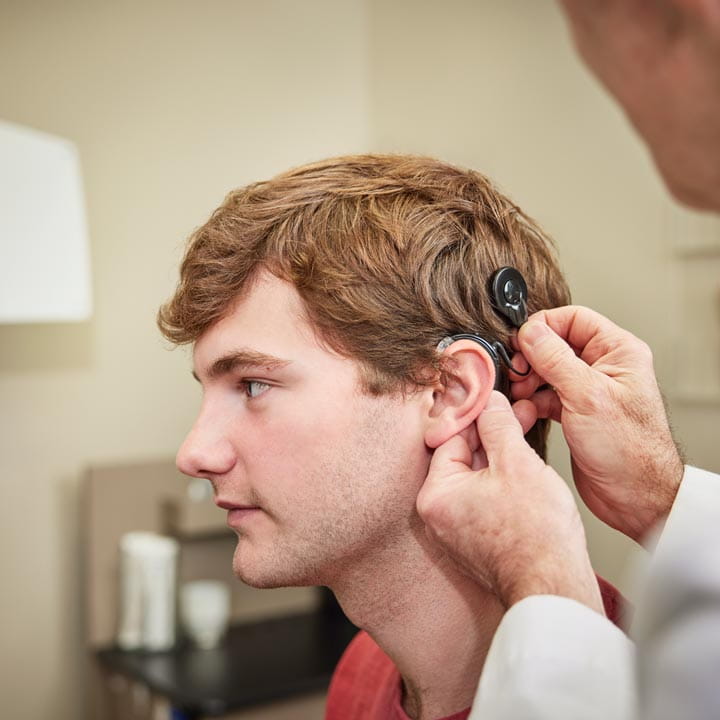 The cochlear implant program spanning The Ohio State University Wexner Medical Center and Nationwide Children’s Hospital is already one of the busiest of its kind in the country. But that hasn’t stopped its physician-leaders from pursuing additional opportunities to strengthen and grow the program.
The cochlear implant program spanning The Ohio State University Wexner Medical Center and Nationwide Children’s Hospital is already one of the busiest of its kind in the country. But that hasn’t stopped its physician-leaders from pursuing additional opportunities to strengthen and grow the program.
By hiring new staff and conducting innovative research related to cochlear implant surgery, the team is making it possible for even more people to achieve better hearing.
Adult program doubles its volume
One of the most striking examples of the Ohio State Wexner Medical Center’s ability to meet the demand for cochlear implant surgery is its recent increase in patient volume. The number of eligible adults who received a cochlear implant grew from an average of 80 to 100 per year to more than 170 in 2023.
Neurotologist Oliver Adunka, MD, MBA, director of the Division of Otology, Neurotology and Cranial Base Surgery, says much of this growth is due to improved access — and services that enhance access.
“We’ve really optimized our operations by hiring more audiologists and expanding our audiology services to two new outpatient clinics in New Albany and Dublin,” Dr. Adunka says. “This means we can evaluate more people with severe to profound hearing loss who want to know if they’re a candidate for cochlear implantation.”
To make it easier for patients who don’t live in the greater Columbus area, the team also partners with audiologists from other clinics throughout Ohio. These professionals provide a convenient, local option for patients who need multiple hearing evaluations before and after having cochlear implant surgery at the Ohio State Wexner Medical Center.
“Because of our active research program, we can also offer cochlear implantation to certain people who might not otherwise meet candidacy criteria or insurance requirements,” says Melissa Schnitzspahn, AuD, audiology manager in the Department of Otolaryngology – Head and Neck Surgery. “For example, someone with good low-frequency hearing who doesn’t meet Medicare criteria might qualify for cochlear implantation by participating in a study on hearing preservation in those low frequencies.”
Pediatric patients benefit from well-integrated, high-volume care
Dr. Adunka also has privileges at Nationwide Children’s, where he and other pediatric otolaryngologists, including Prashant Malhotra, MD, perform around 80 cochlear implant surgeries annually. Here, patients have access to numerous hearing loss specialists, including:
- Audiologists who perform services ranging from hearing evaluations and device activation to cochlear implant mapping
- Speech-language pathologists who help patients interpret sound and learn speech after they receive their cochlear implant
- Genetic counselors who can confirm whether a child’s hearing loss is caused by a genetic condition
- Social workers who can connect families with community resources for children with hearing loss
Dr. Malhotra says this team approach benefits patients and their families in several ways.
“We have a weekly meeting to discuss cases, which includes the surgeons and other professionals our patients interact with,” he says. “This collaboration helps ensure the care we provide is well-coordinated and consensus-driven. Since children need to see multiple specialists before they receive a cochlear implant, this allows us to provide multidisciplinary care quickly and efficiently.”
Drs. Malhotra and Adunka also treat children with more complex needs, including those whose hearing loss is caused by syndromes, abnormal anatomy or conditions like an acoustic neuroma or neurofibromatosis type 2. This means patients can undergo treatments such as skull-base surgery or radiation therapy, and receive a cochlear implant, all under one roof.
Improving outcomes with robotic technology
As part of his ongoing research activities, Dr. Adunka has teamed up with other faculty at The Ohio State University to develop a robotic system that could improve precision during cochlear implant surgery — and help preserve residual hearing in a larger number of patients.
His research partners include Gregory Wiet, MD, a professor of Otolaryngology in the Ohio State College of Medicine, and David Hoelzle, PhD, an associate professor in the Department of Mechanical and Aerospace Engineering within the College of Engineering.
Together, they aim to create a device that causes less trauma when surgeons place cochlear implant electrodes into the delicate cochlea.
“Many people who are eligible for a cochlear implant still have some measurable hearing in one or both ears,” Dr. Adunka says. “However, when we implant the receiver during surgery, we need to manually insert the electrodes into the cochlea to establish an interface between the device and the cochlear nerve endings. During this process, structures inside the cochlea can get damaged, destroying that residual hearing.”
Although some investigational and approved robotic tools are already available for use during cochlear implant surgery, there’s room to refine the technology.
“We’re working on prototypes that would provide more accuracy and control during electrode insertion, because it would provide a level of dexterity that mimics the human hand,” Dr. Adunka says.
